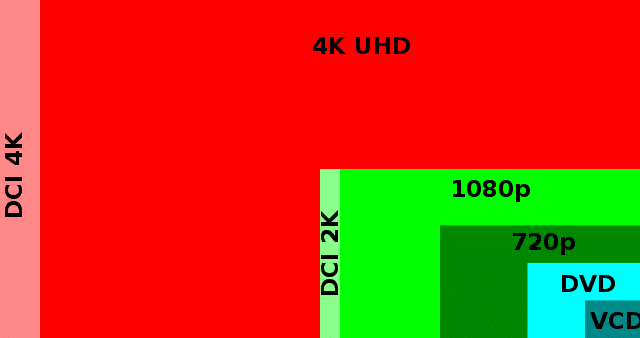Let us know, What is 4K resolution and its importance in this blog post. You might be familiar with high-definition or Full HD, which is the current resolution standard for digital television, Blu-Ray, etc. Besides, this one is the current resolution standard for Netflix and many other digital video players. But you may not know the actual meaning of HD. If you have a full HD display, it means that it is 1,080 pixels tall & 1,920 pixels wide. Vertical & horizontal lines can add up to more than two million individual pixels or nearly six times the number of pixels which exist in a standard DVD picture. When the picture has more pixels, you will get greater clarity and sharpness.
However, if you compare them, it should be stated that the 4K resolution is 2,160 pixels tall & 3,840 pixels wide ( in this case, you should know that the term 4K is derived from the width, and there is also a 4096 pixels wide professional 4K standard). Combining this, it can be said that this will equal to a total number of near about 8.3 million individual pixels, or four times as many pixels as Full HD. The increment in pixels helps to boost a superior image. In addition, it allows the display size to be increased without losing image clarity. That’s why it can be said that 4K is becoming the new standard in high-definition.
Previously, the old DVD standard of 480p was replaced by 720p, and later 1080p replaced that. So, we can guess that the upcoming benchmark will be 4K resolution. Let’s dig into the article to learn what is 4K Resolution and more details about it.
What is 4K Resolution?
Resolution means how many pixels exist in an image or the image’s pixel density. A pixel refers to a small square within a larger image. When there will be more pixels in a picture, you will get better picture quality.
4K resolution indicates an image having nearly 4,000 pixels horizontally. People call 4K also 2160p, referring to the number of vertical pixels in a 4K picture. However, you should know that the “p” in 2160p does not mean pixels. Instead, it refers to progressive scans. You can load pixels into a video frame via this procedure, allowing all pixels to appear simultaneously.
Interlaced scan is an alternative process that loads pixels one line at a time to save bandwidth, but it sacrifices image quality. You have to multiply its vertical & horizontal pixels in order to determine the pixel number in an image. A 4K image includes more than 8 million pixels. A few old computer monitors had 280 x 192 resolution — nearly 53,000 pixels.
4K vs. UHD Resolution:
Although many people use 4K and UHD terms interchangeably, these are technically not the same. In 2005, DCI or Digital Cinema Initiatives set up a standard resolution for the professional cinematic production & display of digital content. According to them, their videos will be called 4K when filmmakers record & display these in 4096 x 2160 resolution. We know it as Cinema 4K. You should know that if you watch a movie at the theatre, it will be seen in cinema 4K.

On the flip side, UHD refers to a consumer display standard. You are able to find this resolution on multiple computers and TVs. This one is a bit lower than Cinema 4K at 3840 x 2160 pixels. In simple terms, the height of UHD is the same as Cinema 4K, but it is less wide.
People call UHD “at-home 4K,” but many devices advertise this as 4K. It is the best resolution you wanna use unless you are going to film on a Hollywood set.
Technically, these are not the same, but still, content creators & advertisers indicate UHD when they say 4K. You will get to see the popular uses of 4K resolution in this article.
Why Should You Use The 4K Resolution?
There are multiple creators who still prefer to film content in 1920 x 1080 resolution. It indicates that 1920 pixels exist horizontally, whereas 1080 pixels exist vertically. Hence, you can see people referring to the resolution as full HD or 1080.
If any video is available in 1080p, the size of the file is usually smaller than those in 4K. Therefore, the amount of storage they take is less on your device. But compared to 4K videos, these are much lower quality. As a result, these appear much less detailed. When you try to zoom in or stand near your monitor, you are able to view the individual pixels in the image. It is the reason content makers move away from 1080 & toward 4K.
Benefit:
One benefit you get when you record videos in 4K resolution is that it provides greater flexibility in post-production. It enables you to enlarge a 4K video more compared to a 1080p video without losing the picture quality. Editing elements is also possible more cleanly, such as graphics & colors.
When you have more data, i.e. pixels to work with, you will get more granular with your edits. Nowadays, multiple TVs & computers display up to 4K screen resolution. However it does not indicate that each video displayed by them will look crisp.
Remember that the resolution of a video relies on two things: the raw footage’s resolution and the capabilities of the recording & editing software.
Recording a video in 1080p will have a lower resolution, even on a screen that can display 4K. Whether you record a video in 4K but edit this in software that is capable of exporting only in 1080p, then you will see that the video has a 1080 resolution.
Several content creators prefer to record in the best possible quality, like 4K and export in 1080p. Thus, it is possible to create maximum quality, but your viewers’ devices may process at a resolution.
Whether you are willing your viewers to see your videos on their 4K screens, you have to record them & edit them later in 4K.
Basic Viewing Requirements For 4K Video:
4K adaptive bit rate streams need from 10-20 Mbps of bandwidth. Netflix, which is an online video streaming service provider, will be able to stream 4K content using at least 15 Mbps or higher internet connection speed.
In order to see 4K resolution content, you will need a 4K TV or 4K monitor. An ultra HD specification was announced by the UHD Alliance at the 2016 Consumer Electronics Show with the aim of supporting the adoption of 4K resolution videos. This Alliance is a coalition of more than 50 technology companies, entertainment studios & consumer electronics manufacturers. This specification lists those features which need to be added to the devices, such as televisions and Blu-ray players, in order to make sure that these support other 4K content & hardware.
In order to receive the specification, devices have to provide the following:
- A minimum of 3840×2160 pixels or higher resolution;
- 10-bit color depth. It will allow 1,024 shades of each of the three initial colours— red, green and blue;
- HDR or High dynamic range for colour accuracy;
- A mix of black level & peak brightness. It needs to be more than 1,000 nits peak brightness & less than 0.05 nits black level. Or it should be more than 540 nits peak brightness & less than 0.0005 nits black level.
Recording:
Detail Benefit:
One of the main benefits you get while recording video at the 4K standard is that fine spatial detail is resolved properly. Individual still frames, which you extract from 3840×2160-pixel video footage, might work as 8.3-megapixel still photographs, while 2.1 megapixels at 1080p & 0.9 megapixels at 720p. Suppose the final video resolution gets decreased to 2K from a 4K recording. If this is the case, more detail will be apparent than might be gained from a native 2K recording.
Increased fineness & contrast can happen with output to DVD & Blu-ray. A few cinematographers are able to record at 4K with the Super 35 film format in order to offset resolution loss, which can occur during video processing.
Chroma Subsampling:
Mobile phones and several other consumer electronics store video footage in Y′CBCR format with 4:2:0 chroma subsampling. It is capable of recording colour information at only one-quarter of the resolution as the brightness information. For the 3840×2160 video, it indicates that the color information is stored at 1920×1080.
Bit Rates:
Compared to 1080p, 2160p footage can be recorded at much higher bit rates by consumer cameras & mobile phones. The higher bit rate can decrease the visibility of compression artifacts despite being viewed on monitors with a lower resolution than 2160p.
4K Video Advantages And Disadvantages:
It can provide improved image quality at a higher resolution. Higher resolution is advantageous in industries which use detailed images, like healthcare & manufacturing.
Drawbacks of 4K resolution are high bandwidth & storage needs that may affect network infrastructure negatively.
4K Resolution Standards And Upscaling:
Many video codecs and standards are compatible with 4K video needs & bandwidth.
- A video compression standard is 265. The International Telecommunication Union (ITU) approved this standard in January 2013.
- 265 is called High Efficiency Video Coding. The design of it allows it to support HD video with resolutions up to 8K. It is capable of incorporating scalable video coding & promising twice the data compression at the same quality level as its predecessor, H.264.
- VP9 is an open video compression codec that Google has developed. The design of it makes it compatible with 4K video streaming, but the bandwidth is reduced by 50%. First, it launched on YouTube in order to support 4K video streaming. In June 2013, it was released officially. It is supported by many web browsers, like Google Chrome, Mozilla Firefox and Opera. Like H.265, it hasn’t experienced the same widespread industry adoption.
You are capable of upscaling lower-resolution images on 4K TVs & 4K monitors. For instance, 1080p HD can be upscaled. The 4K devices come with dedicated hardware like a video scaler & image processing algorithms. These are used to boost the pixel count in lower-resolution images. Dedicated upscaling boxes are used to provide more processing power than hardware. These are capable of upscaling lower resolutions to 4K.
- HDR refers to a specification which can expand the bright range & dark levels you see on any 4K device. It is used to expand colour vibrancy. In addition, it can simulate real-world brightness & darkness by expanding richness.
Is 4K The Highest Resolution?
This one is the highest resolution on most devices. That’s why it is the most popular choice among videographers. You can even film at a higher resolution: 8K, or 7680 x 4320. It is about 33 million pixels.
But if you want to film in 8K, you will need a huge amount of bandwidth. Additionally, you need a lot of device storage, which is one of the most important aspects you should remember. You should know that most people do not have devices which support 8K monitors. Therefore, it is not recommended for most content creators.
The Future Of 4K Video:
At present, we are in the midst of the transition from 1080 to 4K. Several streaming services, such as Netflix, Amazon, Hulu, and Disney Plus, provide 4K shows & movies, whereas others don’t. However, in this case, it needs to be mentioned that broadcast television is lagging a bit behind. But, the number of 4K channels is increasing steadily. TikTok & Instagram cap video resolution at 1080. On the other hand, 4K videos are allowed by Facebook & YouTube. Gaming consoles have also started offering 4K.
Internet bandwidth is a major bottleneck you should consider. In this case, it does not only indicate your personal at-home internet. Instead, it refers to the World Wide Web. There are multiple bandwidths to go around. You should know that 4K videos consume a lot of bandwidth.
It is also one of the reasons you should not upgrade everything to 4K. Rather than that, the changes you could see in the near future are related to HDR, OLED & other technologies. Hence, you should know that OLED stands for organic light-emitting diode. At the same time, the standard form of HDR is high dynamic range. This helps to boost the colour quality & contrast of your screen. This makes whites look brighter, whereas blacks will look darker. Moreover, these will not demand more of your bandwidth.
The Bottom Line:
Remember that 4K media is not so rare, like the old days. In fact, most new films, shows, & even video games are engineered from the ground up having the 4K screen in mind. There is nothing to worry about when you are not currently viewing any 4K content. The reason is that most 4K TV sets perform well when it comes to upscaling lower-res sources.
Frequently Asked Questions:
Is 4K 3840×2160 or 4096×2160?
4K is technically 4096 x 2160 pixels. Meanwhile, 3840 x 2160 pixels is a UHD (Ultra High Definition) resolution. Several companies advertise consumer devices as 4k, but these aren’t. For instance, companies advertise computers, phones and TVs as 4k, but these are actually UHD.
What is better, 4K or UHD?
Compared to UHD, 4K is a bit higher resolution. Thus, one includes 256 more horizontal pixels, or tiny squares, which are used to create a picture. Therefore, it can be stated that 4K screens and videos are more detailed than UHD. But the difference will not be noticed unless you do any intensive colour editing on the videos or stand inches from the screen.
What does 4K resolution mean?
It indicates that a picture or a video comes with 4,000 horizontal pixels. Images with more pixels come with a more detailed design, even when enlarged. Whereas in comparison, the resolution that is under 4K has only 1920 horizontal pixels.







